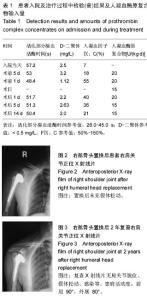| [1] 6 Factor VIII Concentrates, Factor VIII/von Willebrand Factor Concentrates, Factor IX Concentrates, Activated Prothrombin Complex Concentrates. Transfus Med Hemother. 2009;36(6):409-418.
[2] 刘颖,陈丽霞.血友病患者日常生活活动能力及其影响因素分析[J]. 中华物理医学与康复杂志, 2013, 35(3): 205-208.
[3] Acharya SS. Exploration of the pathogenesis of haemophilic joint arthropathy: understanding implications for optimal clinical management. Br J Haematol. 2012;156(1):13-23.
[4] Roosendaal G, Lafeber FP. Pathogenesis of haemophilic arthropathy. Haemophilia. 2006;12 Suppl 3:117-121.
[5] Yoo MC, Cho YJ, Kim KI, et al. The outcome of cementless total hip arthroplasty in haemophilic hip arthropathy. Haemophilia. 2009;15(3):766-773.
[6] 李斌.血友病的综合治疗[J]. 血栓与止血学, 2011, 17(2): 88-91.
[7] 焦丽华,代旭兰,刘文芳.凝血酶原复合物的制备及其临床应用进展[J].中国输血杂志, 2008, 21(9):737-741.
[8] Sørensen B, Spahn DR, Innerhofer P, et al. Clinical review: Prothrombin complex concentrates--evaluation of safety and thrombogenicity. Critical Care. 2011; 15(1):201.
[9] Majeed A, Eelde A, Ågren A, et al. Thromboembolic safety and efficacy of prothrombin complex concentrates in the emergency reversal of warfarin coagulopathy. Thromb Res. 2012;129(2):146-151.
[10] Seitz R, Dodt J. Virus safety of prothrombin complex concentrates and factor IX concentrates. Thromb Res. 1999;95(4 Suppl 1):S19-23.
[11] Keeling D, Tait C, Makris M. Guideline on the selection and use of therapeutic products to treat haemophilia and other hereditary bleeding disorders. Haemophilia. 2008;14(4):671-684.
[12] Yoshitake S, Schach BG, Foster DC, et al. Nucleotide sequence of the gene for human factor IX (antihemophilic factor B). Biochemistry. 1985;24(14): 3736-3750.
[13] Shapiro AD, Ragni MV, Valentino LA, et al. Recombinant factor IX-Fc fusion protein (rFIXFc) demonstrates safety and prolonged activity in a phase 1/2a study in hemophilia B patients. Blood. 2012; 119(3):666-672.
[14] Roth DA, Kessler CM, Pasi KJ, et al. Human recombinant factor IX: safety and efficacy studies in hemophilia B patients previously treated with plasma-derived factor IX concentrates. Blood. 2001; 98(13):3600-3606.
[15] 王朝荣.乙型血友病患者的治疗进展[J]. 国际输血及血液学杂志, 2013, 36(2):147-150.
[16] Takedani H, Shima M, Horikoshi Y, et al. Ten-year experience of recombinant activated factor VII use in surgical patients with congenital haemophilia with inhibitors or acquired haemophilia in Japan. Haemophilia. 2015;21(3):374-379.
[17] Thompson AR. Structure, function, and molecular defects of factor IX. Blood. 1986;67(3):565-572.
[18] Hirosawa S, Fahner JB, Salier JP, et al. Structural and functional basis of the developmental regulation of human coagulation factor IX gene: factor IX Leyden. Proc Natl Acad Sci U S A. 1990;87(12):4421-4425.
[19] Nishimura H, Takeya H, Miyata T, et al. Factor IX Fukuoka. Substitution of ASN92 by His in the second epidermal growth factor-like domain results in defective interaction with factors VIIa/X. J Biol Chem. 1993;268(32):24041-24046.
[20] 陈金中, 薛京伦. 中国血友病B生物基因治疗研究状况[J]. 科学通报, 2009,54(18):2766-2770.
[21] Wang L, Calcedo R, Wang H, et al. The pleiotropic effects of natural AAV infections on liver-directed gene transfer in macaques. Mol Ther. 2010;18(1):126-134.
[22] Bigger BW, Siapati EK, Mistry A, et al. Permanent partial phenotypic correction and tolerance in a mouse model of hemophilia B by stem cell gene delivery of human factor IX. Gene Ther. 2006;13(2):117-126.
[23] Mingozzi F, Chen Y, Murphy SL, et al. Pharmacological modulation of humoral immunity in a nonhuman primate model of AAV gene transfer for hemophilia B. Mol Ther. 2012;20(7):1410-1416.
[24] Nathwani AC, Tuddenham EG, Rangarajan S, et al. Adenovirus-associated virus vector-mediated gene transfer in hemophilia B. N Engl J Med. 2011;365(25): 2357-2365.
[25] Zhang J, Xu L, Haskins ME, et al. Neonatal gene transfer with a retroviral vector results in tolerance to human factor IX in mice and dogs. Blood. 2004;103(1): 143-151.
[26] 中国医学会血液学会血栓与止血学组. 血友病诊断与治疗中国专家共识[J]. 中华血液学杂志, 2011, 32(3) 212-213.
[27] Bolton-Maggs PH, Pasi KJ. Haemophilias A and B. Lancet. 2003;361(9371):1801-1809.
[28] Rodriguez-Merchan EC. Aspects of current management: orthopaedic surgery in haemophilia. Haemophilia. 2012;18(1):8-16.
[29] Miles J, Goddard NJ. The impact of haemophilia on the success of total hip arthroplasty. Haemophilia. 2008; 14(1): 81-84.
[30] Wang K, Street A, Dowrick A, et al. Clinical outcomes and patient satisfaction following total joint replacement in haemophilia--23-year experience in knees, hips and elbows. Haemophilia. 2012;18(1): 797-798. |

